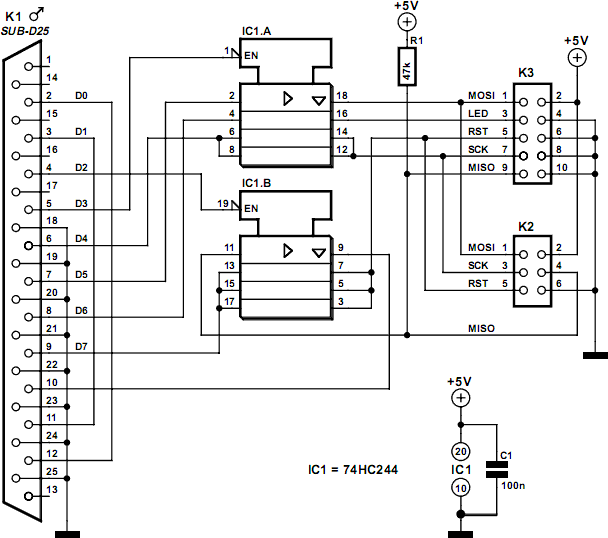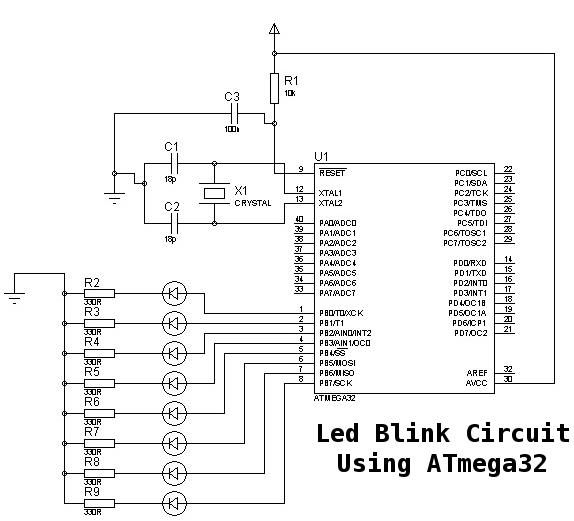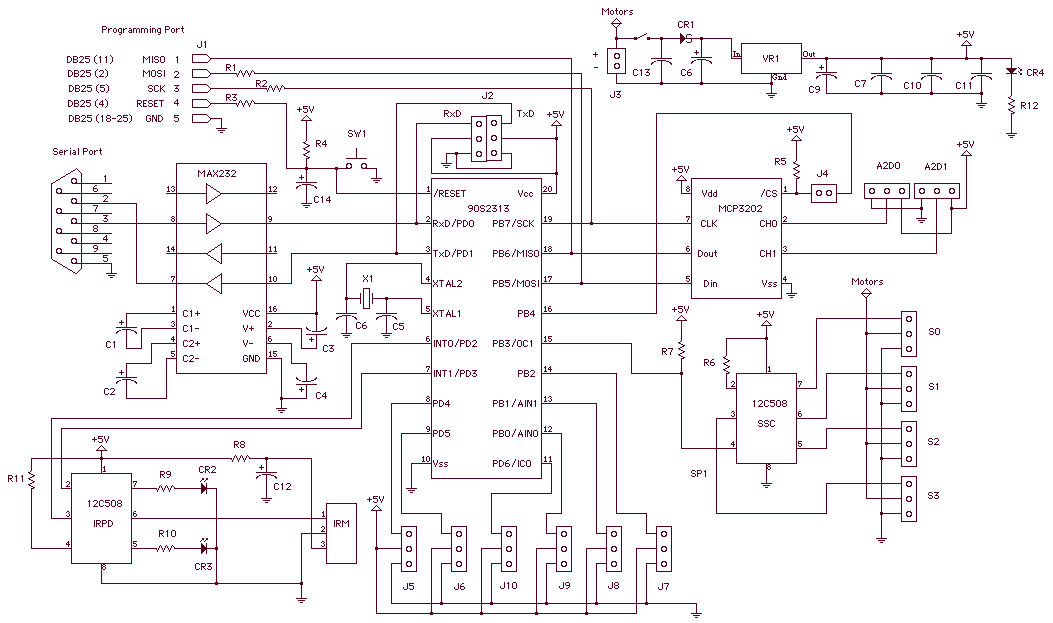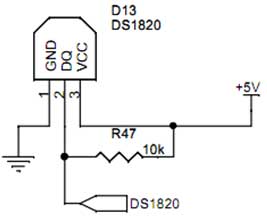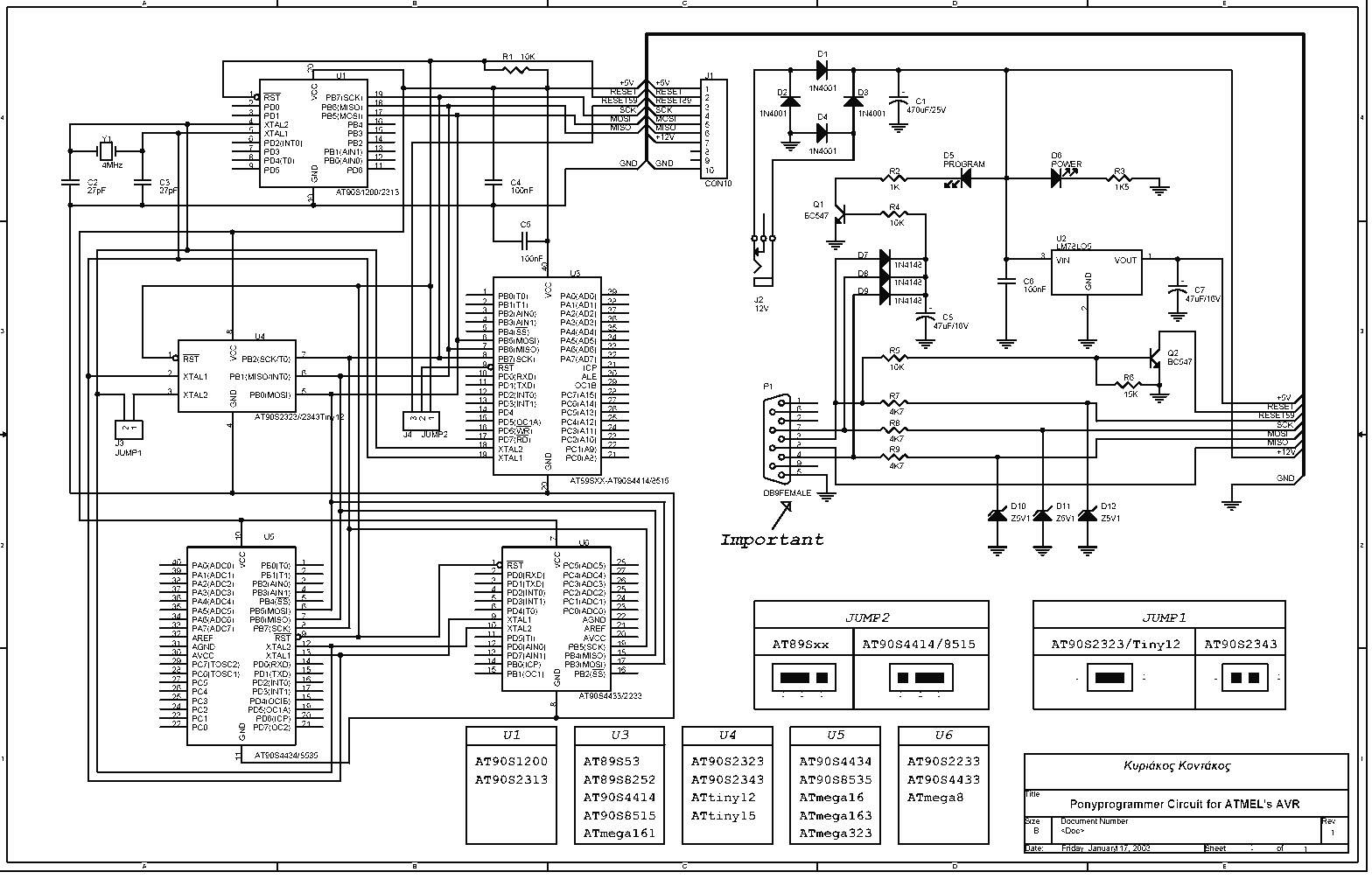
AVR Butterfly MP3

AVR ISP interface (optional but useful if the bootloader is not preferred, if budget constraints prevent the use of JTAG, or if AVR Studio has crashed and disabled on-chip debugging). The following is the updated bill of materials for the latest version of the PCB. The components are available from Farnell and Digi-Key, with a few exceptions. If the list is not visible below, it can also be found elsewhere. Basic software is available in CVS to check the operation of the hardware and test individual aspects. The system test module can be accessed here (Note: this has not been updated for some time). The Rev_B design now incorporates a low-dropout 3V regulator, alleviating power source issues. When using 3V (2 x AA cells), the regulator on the PCB can be replaced with a jumper from VIN to VOUT. The Rev_C design utilizes a MAX1811 to manage charging a Li-Ion (4.2V) battery from a USB port. Although the design should ideally regulate the battery to 3.3V, it currently does not. The Rev_D board features a switched-capacitor regulator (Texas Instruments REG710-3.3) to maintain Vcc at 3.3V. An unmodified Rev_C board can function, but the lifespan of the MMC may be compromised. The Rev_E board has substituted the REG710-3.3 with a National Semiconductor LP2891 ultra-low dropout regulator, which consumes significantly less current while allowing for power extraction from the battery across its recommended operating voltage range.
The AVR ISP interface serves as a critical tool for programming and debugging AVR microcontrollers without the need for an additional bootloader. This interface is particularly advantageous in scenarios where budget limitations restrict the use of more expensive debugging tools like JTAG or when software environments such as AVR Studio become unstable.
The bill of materials (BOM) for the latest PCB version is essential for ensuring that all components are readily available for assembly and testing. Sourcing components from reputable suppliers like Farnell and Digi-Key guarantees quality and reliability, though some specialized components may require alternative sourcing.
Basic software tools provided in the CVS repository facilitate hardware testing and operational verification, allowing developers to assess individual circuit functions effectively. The system test module, although outdated, remains a valuable resource for initial hardware validation.
The Rev_B design's integration of a low-dropout (LDO) 3V regulator addresses common power supply concerns, enabling the use of standard battery configurations (such as two AA cells). The design's flexibility allows users to bypass the regulator by using a jumper, simplifying the setup for low-power applications.
In the Rev_C design, the inclusion of the MAX1811 for charging a Li-Ion battery from a USB source highlights the shift towards modern power management solutions. Although the design does not yet regulate the battery output to 3.3V, it lays the groundwork for future improvements.
The Rev_D board's implementation of the Texas Instruments REG710-3.3 switched-capacitor regulator represents a significant enhancement in maintaining a stable Vcc at 3.3V. This stability is crucial for ensuring optimal performance and longevity of connected components, such as MMCs, which may suffer from reduced lifespan if powered improperly.
The Rev_E design further optimizes power consumption by replacing the REG710-3.3 with the LP2891 ultra-low dropout regulator from National Semiconductor. This transition not only reduces current draw but also enhances the ability to draw power from the battery effectively, ensuring consistent performance across a wider range of operating conditions.
Overall, the evolution of these designs reflects a commitment to improving functionality, efficiency, and user experience in AVR microcontroller applications.AVR ISP interface (optional but handy if you don`t like the boot loader, are too poor for a JTAG or AVR studio just crashed and disabled the on chip debugging ;) ) The following is the up to date bill of materials for the latest version of the PCB. The parts are available from Farnell and digikey with the exception of a few items. If you cannot se e the list below then it is also available here. There is some basic software in the CVS that can be used to check the operation of the Hardware and test individual aspects of the hardware. You can find the systems test module here. (NOTE: This has not been updated for some time) The Rev_B design now includes a low drop out 3V regulator so power source is not really an issue, but if using 3V (2 x AA cells) then you can just replace the regulator on the PCB with a jumper from vin to vout.
The Rev_C deisgn uses a MAX1811 to handle charging a LiION (4. 2V) Battery from a USB port. The design should really regulate the battery to 3. 3V, but doesn`t yet. The Rev_D board now includes a switched capacitor regulator (Texus Instruments REG710-3. 3) to maintain Vcc at 3. 3V. Using an unmodified Rev_C board will work but the life time of the MMC will be reduced. The Rev_E board has replaced the REG710-3. 3 with a National Semiconductor LP2891 ultra low dropout regulator. This component uses much less current than the former part, while allowing us to still extract power from the battery over its recomended operating voltage range 🔗 External reference
The AVR ISP interface serves as a critical tool for programming and debugging AVR microcontrollers without the need for an additional bootloader. This interface is particularly advantageous in scenarios where budget limitations restrict the use of more expensive debugging tools like JTAG or when software environments such as AVR Studio become unstable.
The bill of materials (BOM) for the latest PCB version is essential for ensuring that all components are readily available for assembly and testing. Sourcing components from reputable suppliers like Farnell and Digi-Key guarantees quality and reliability, though some specialized components may require alternative sourcing.
Basic software tools provided in the CVS repository facilitate hardware testing and operational verification, allowing developers to assess individual circuit functions effectively. The system test module, although outdated, remains a valuable resource for initial hardware validation.
The Rev_B design's integration of a low-dropout (LDO) 3V regulator addresses common power supply concerns, enabling the use of standard battery configurations (such as two AA cells). The design's flexibility allows users to bypass the regulator by using a jumper, simplifying the setup for low-power applications.
In the Rev_C design, the inclusion of the MAX1811 for charging a Li-Ion battery from a USB source highlights the shift towards modern power management solutions. Although the design does not yet regulate the battery output to 3.3V, it lays the groundwork for future improvements.
The Rev_D board's implementation of the Texas Instruments REG710-3.3 switched-capacitor regulator represents a significant enhancement in maintaining a stable Vcc at 3.3V. This stability is crucial for ensuring optimal performance and longevity of connected components, such as MMCs, which may suffer from reduced lifespan if powered improperly.
The Rev_E design further optimizes power consumption by replacing the REG710-3.3 with the LP2891 ultra-low dropout regulator from National Semiconductor. This transition not only reduces current draw but also enhances the ability to draw power from the battery effectively, ensuring consistent performance across a wider range of operating conditions.
Overall, the evolution of these designs reflects a commitment to improving functionality, efficiency, and user experience in AVR microcontroller applications.AVR ISP interface (optional but handy if you don`t like the boot loader, are too poor for a JTAG or AVR studio just crashed and disabled the on chip debugging ;) ) The following is the up to date bill of materials for the latest version of the PCB. The parts are available from Farnell and digikey with the exception of a few items. If you cannot se e the list below then it is also available here. There is some basic software in the CVS that can be used to check the operation of the Hardware and test individual aspects of the hardware. You can find the systems test module here. (NOTE: This has not been updated for some time) The Rev_B design now includes a low drop out 3V regulator so power source is not really an issue, but if using 3V (2 x AA cells) then you can just replace the regulator on the PCB with a jumper from vin to vout.
The Rev_C deisgn uses a MAX1811 to handle charging a LiION (4. 2V) Battery from a USB port. The design should really regulate the battery to 3. 3V, but doesn`t yet. The Rev_D board now includes a switched capacitor regulator (Texus Instruments REG710-3. 3) to maintain Vcc at 3. 3V. Using an unmodified Rev_C board will work but the life time of the MMC will be reduced. The Rev_E board has replaced the REG710-3. 3 with a National Semiconductor LP2891 ultra low dropout regulator. This component uses much less current than the former part, while allowing us to still extract power from the battery over its recomended operating voltage range 🔗 External reference
